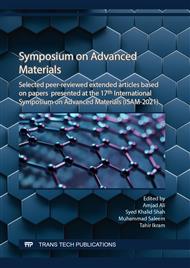p.43
p.51
p.57
p.65
p.71
p.79
p.89
p.95
p.105
Synthesis and Characterization of Silica Coated Magnetite Nanoparticle Clusters for Viral RNA Extraction
Abstract:
Magnetite nanoparticles or iron oxide nanoparticles are the most explored magnetic nanoparticles till recent times, particularly due to their attractive properties for biomedical applications such as viral RNA extraction. The physical and chemical properties of magnetite nanoparticles and their clusters largely depend on the synthesis method and chemical structure. Co-precipitation method was used to synthesize magnetite nanoparticles at varying process parameters. The nanoparticles were coated with silicon-oxide using Stober method at different deposition durations. These particles were characterized by X-Ray Diffraction, Scanning Electron Microscopy, vibrating sample Magnetometer and PCR testing to study the phases formed, morphology, size, magnetic properties and RNA extraction efficiency. The synthesized magnetite nanoparticles were in the range of 10 to 100 nm; suitable for super-para-magnetic behavior. The maximum saturation magnetization achieved for synthesized paramagnetic beads was 56 emu and RNA extraction efficiency was more than 80% as compared to commercial beads.
Info:
Periodical:
Pages:
71-77
Citation:
Online since:
August 2022
Authors:
Price:
Сopyright:
© 2022 Trans Tech Publications Ltd. All Rights Reserved
Share:
Citation:



